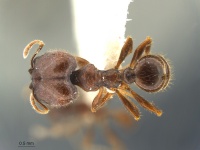Pheidole balzani
| Pheidole balzani | |
|---|---|

| |
| Scientific classification | |
| Kingdom: | Animalia |
| Phylum: | Arthropoda |
| Class: | Insecta |
| Order: | Hymenoptera |
| Family: | Formicidae |
| Subfamily: | Myrmicinae |
| Tribe: | Attini |
| Genus: | Pheidole |
| Species: | P. balzani |
| Binomial name | |
| Pheidole balzani Emery, 1894 | |
Nothing is known about the biology of balzani.
Identification
See the description in the nomenclature section.
Keys including this Species
Distribution
Known only from the type locality and Rancho Grande, Venezuela, 1100 m. (Wilson 2003)
Distribution based on Regional Taxon Lists
Neotropical Region: Bolivia (type locality), Venezuela.
Distribution based on AntMaps
Distribution based on AntWeb specimens
Check data from AntWeb
Countries Occupied
| Number of countries occupied by this species based on AntWiki Regional Taxon Lists. In general, fewer countries occupied indicates a narrower range, while more countries indicates a more widespread species. |

|
Estimated Abundance
| Relative abundance based on number of AntMaps records per species (this species within the purple bar). Fewer records (to the left) indicates a less abundant/encountered species while more records (to the right) indicates more abundant/encountered species. |

|
Biology
Castes
Nomenclature
The following information is derived from Barry Bolton's Online Catalogue of the Ants of the World.
- balzani. Pheidole balzani Emery, 1894c: 161 (s.w.) BOLIVIA. See also: Wilson, 2003: 661.
Unless otherwise noted the text for the remainder of this section is reported from the publication that includes the original description.
Description
From Wilson (2003): DIAGNOSIS A large, robust member of the tristis group with quadrate head shape in full-face view, similar to Pheidole fabricator, Pheidole gaigei, Pheidole godmani, Pheidole grantae (=Pheidole exarata), Pheidole nigella and Pheidole tristis, and distinguished by the following combination of traits.
Major: head quadrate, with shallow median occipital cleft in full-face view; hind femora swollen in middle; frontal lobe extended as short angular protrusion in side view; humerus in dorsal-oblique view very prominent, and right-subtriangular in outline; postpetiole bell-shaped from above; all of pronotal dorsum transversely carinulate.
Minor: humerus prominent, subangulate; carinulae originating from frontal carinae curve laterally toward sides of head; pronotal dorsum transversely carinulate.
MEASUREMENTS (mm) Holotype major: HW 1.58, HL 1.66, SL 0.84, EL 0.20, PW 0.80. Paratype minor: HW 0.72, HL 0.72, SL 0.72, EL 0.12, PW 0.48.
COLOR Major: body and mandibles dark reddish brown, appendages medium brownish yellow.
Minor: body plain medium brown, appendages plain light brown.
Figure. Upper: holotype, major; the leg part shown is the right hind femur . Lower: minor, tentatively associated with holotype by Carlos Emery (Bolivia). Scale bars = 1 mm.
Type Material
Salinas, Rio Beni, Bolivia. Museo Civico di Storia Naturale, Genoa - as reported in Wilson (2003)
Etymology
Named after the collector, Luigi Balzan. (Wilson 2003)
References
- Emery, C. 1894d. Studi sulle formiche della fauna neotropica. VI-XVI. Bull. Soc. Entomol. Ital. 26: 137-241 (page 161, soldier, worker described)
- Wilson, E. O. 2003. Pheidole in the New World: A dominant, hyperdiverse ant genus. Harvard University Press, Cambridge, MA. (page 661, fig. major, minor described)
References based on Global Ant Biodiversity Informatics
- Emery C. 1894. Studi sulle formiche della fauna neotropica. VI-XVI. Bullettino della Società Entomologica Italiana 26: 137-241.
- Fernández, F. and S. Sendoya. 2004. Lista de las hormigas neotropicales. Biota Colombiana Volume 5, Number 1.


